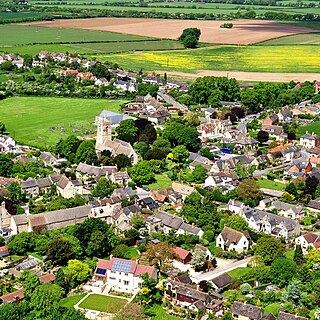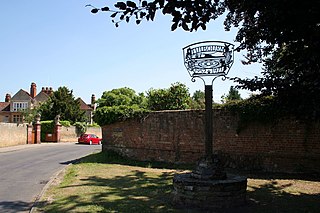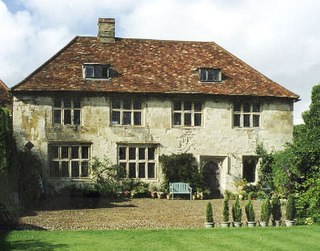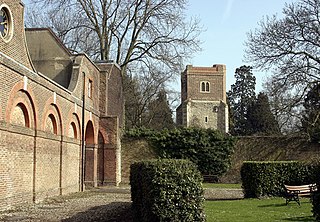
Fulbourn Manor is a Grade II listed building in the English county of Cambridgeshire [1] and the sole surviving manor of the Five Manors of Fulbourn.

Fulbourn Manor is a Grade II listed building in the English county of Cambridgeshire [1] and the sole surviving manor of the Five Manors of Fulbourn.
The manor was built in 1788 [2] or maybe earlier. An account from 1495 states that Richard Berkeley and his wife Anne Berkeley settled a debt of 1,000 marks with four manors of Fulbourn, which were stated as Zouches, Manners, Shardelowes and Fulbourn. [3]
It was largely rebuilt around 1910 by Dudley Newman. [4] Reconstruction preserved part of the 18th-century building.

Oxfordshire is a ceremonial county in South East England. The county is bordered by Northamptonshire and Warwickshire to the north, Buckinghamshire to the east, Berkshire to the south, and Wiltshire and Gloucestershire to the west. The city of Oxford is the largest settlement and county town.

Fulbourn is a village in Cambridgeshire, England, with evidence of settlement dating back to Neolithic times. The village was probably established under its current name by 1200. The waterfowl-frequented stream after which it was named lies in the east, close to the division between arable and fenland.

Wormleybury is an 18th-century house surrounded by a landscaped park of 57 ha near Wormley in Broxbourne, Hertfordshire, England, a few miles north of Greater London. The house was rebuilt in the 1770s from an earlier house built in 1734. The house is a Grade I listed building. The garden is well known for its historic rare plant collection. There is a crescent shaped lake in the grounds, bordered by woods on three sides.

Attingham Park is an English country house and estate in Shropshire. Located near the village of Atcham, on the B4380 Shrewsbury to Wellington road. It is owned by the National Trust and is a Grade I listed building.

Barnwell Manor is a Grade II listed country estate near the village of Barnwell, about 2.5 miles (4.0 km) south of Oundle, in Northamptonshire, England. The historic former home of the Duke and Duchess of Gloucester, as of 2017 it was occupied by Windsor House Antiques. In September 2022, Prince Richard, Duke of Gloucester, put the manor up for sale for £4.75 million.

Coade stone or Lithodipyra or Lithodipra is stoneware that was often described as an artificial stone in the late 18th and early 19th centuries. It was used for moulding neoclassical statues, architectural decorations and garden ornaments of the highest quality that remain virtually weatherproof today.

Roke Manor is a 17th-century manor house approximately 1.2 miles (2 km) north-west of Romsey in Hampshire, England. The house and 22-acre (8.9 ha) grounds are the headquarters of Roke Manor Research Ltd, a subsidiary of Chemring Group.

Beverston Castle, also known as Beverstone Castle or Tetbury Castle, was constructed as a medieval stone fortress in the village of Beverston, Gloucestershire, England. The property is a mix of manor house, various small buildings, extensive gardens and the medieval ruins of the fortified building. The castle was founded in 1229 by Maurice de Gaunt.

Fleam Dyke is a linear earthwork between Fulbourn and Balsham in Cambridgeshire, initiated some time between AD 330 and AD 510. It is three miles long and seven metres high from ditch to bank, and its ditch faces westwards, implying invading Saxons as its architects. Later, it formed a boundary of the Anglo-Saxon administrative division of Flendish Hundred. At a prominent point, the earthwork runs beside Mutlow Hill, crowned by a 4000-year-old Bronze Age burial mound.
Cotheridge Court is a Grade II* listed ancient manor house situated in the south-western part of Cotheridge, in the county of Worcestershire, England, and birthplace of Herbert Bowyer Berkeley. The house bought in 1615 by William Berkeley, eldest son of Rowland Berkeley (1548-1611) of Spetchley, was owned and lived in by the Berkeley family for nearly 350 years, but the manor is over one thousand years old. This family descended from the Berkeleys of Berkeley Castle Gloucestershire, and Eadnoth. Cotheridge Court is now a private residence of sub-divided flats.

Hinxworth Place is a medieval manor house near Hinxworth, Hertfordshire, England.

Peckforton is a scattered settlement and civil parish in the unitary authority of Cheshire East and the ceremonial county of Cheshire, England. The settlement is located 6.5 miles (10.5 km) to the north east of Malpas and 7.5 miles (12.1 km) to the west of Nantwich. The civil parish covers 1,754 acres (710 ha), with an estimated total population of 150 in 2006. The area is predominantly agricultural. Nearby villages include Bulkeley to the south, Beeston to the north, Higher Burwardsley to the west, Spurstow to the east and Bunbury to the north east.

Fulbourn Fen is a 27.3-hectare (67-acre) biological Site of Special Scientific Interest east of Fulbourn, Cambridgeshire. It is privately owned and managed by the Wildlife Trust for Bedfordshire, Cambridgeshire and Northamptonshire.

Asthall Manor is a gabled Jacobean Cotswold manor house in Asthall, Oxfordshire. It was built in about 1620 and altered and enlarged in about 1916. The house is Grade II listed on the National Heritage List for England.

Glemham Hall or Little Glemham Hall is an Elizabethan and Georgian country house, set in around 300 acres (120 ha) of park land on the outskirts of the village of Little Glemham in Suffolk, England. It is a Grade I listed building.

Milton Hall near Peterborough, is the largest private house in Cambridgeshire, England. As part of the Soke of Peterborough, it was formerly in Northamptonshire. It dates from 1594, being the historical home of the Fitzwilliam family, and is situated in an extensive park in which some original oak trees from an earlier Tudor deer park survive. The house is a Grade I listed building; the garden is Grade II*.

Gravetye Manor is a manor house located near East Grinstead, West Sussex, England. The former home of landscape gardener William Robinson, it is now a hotel and restaurant holding, in 2020, one star in the Michelin Guide, and is listed Grade I on the National Heritage List for England, its gardens are also Grade II* listed on the Register of Historic Parks and Gardens.

Caludon Castle is a Scheduled Ancient Monument and Grade I listed building in Coventry, in the West Midlands of England. A second moated site 190 metres (620 ft) to the south is a Scheduled Ancient Monument in its own right. The castle is now a ruin, and all that remains is a large fragment of sandstone wall. What remains of the estate is now an urban park, owned and run by Coventry City Council, but much of it was sold and developed into housing estates in the early 20th century.

Cranford Countryside Park is a 144-acre public park in Cranford, in the London Borough of Hillingdon, England. Situated in close proximity to Heathrow Airport, it is bordered by the M4 Motorway to the north, the A312 trunk road to the east, and by the towns of Harlington and Cranford to the southwest and southeast respectively. Although Cranford is mostly within the London Borough of Hounslow, the park itself is in the London Borough of Hillingdon, as it straddles the southernmost point of this borough. Although the park is in an urban location, it is vehicle-accessible only by a small road before a motorway entrance slip, and as such it has been described as a 'hidden gem'.

Zouches Manor was an Anglo-Saxon moated manor in Fulbourn Fen, a Site of Special Scientific Interest in the village of Fulbourn, Cambridgeshire, England. It is one of the historic Five Manors of Fulbourn and recorded to have existed 1066 AD to 1539 AD.
52°10′57″N0°13′24″E / 52.182631°N 0.223436°E